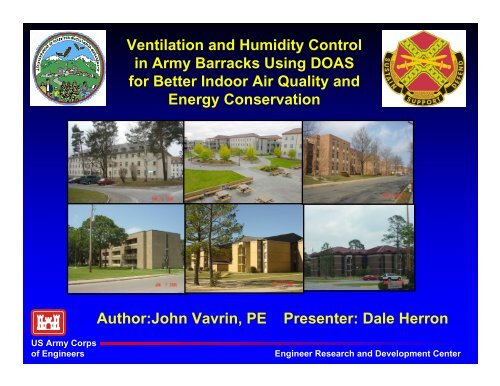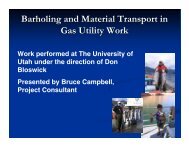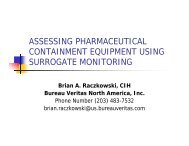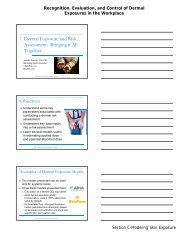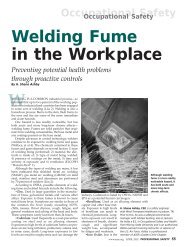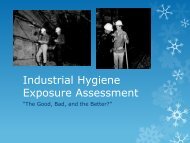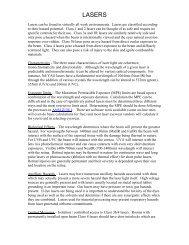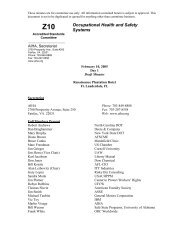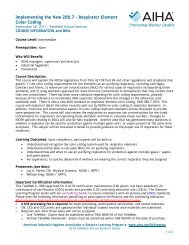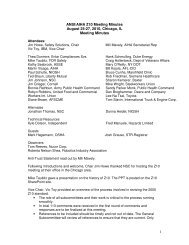Ventilation and Humidity Control in Army Barracks Using DOAS for ...
Ventilation and Humidity Control in Army Barracks Using DOAS for ...
Ventilation and Humidity Control in Army Barracks Using DOAS for ...
You also want an ePaper? Increase the reach of your titles
YUMPU automatically turns print PDFs into web optimized ePapers that Google loves.
US <strong>Army</strong> Corps<br />
of Eng<strong>in</strong>eers<br />
<strong>Ventilation</strong> <strong>and</strong> <strong>Humidity</strong> <strong>Control</strong><br />
<strong>in</strong> <strong>Army</strong> <strong>Barracks</strong> Us<strong>in</strong>g <strong>DOAS</strong><br />
<strong>for</strong> Better Indoor Air Quality <strong>and</strong><br />
Energy Conservation<br />
Author:John Vavr<strong>in</strong>, PE Presenter: Dale Herron<br />
Eng<strong>in</strong>eer Research <strong>and</strong> Development Center
Then<br />
What a difference !!<br />
Now
Introduction<br />
• U.S. Military barracks range from the wooden World War II-era<br />
build<strong>in</strong>gs to the college-dorm-type dwell<strong>in</strong>gs of today <strong>and</strong> are<br />
located <strong>in</strong> all climatic zones<br />
• U.S. <strong>Army</strong> has been steadily build<strong>in</strong>g <strong>and</strong> renovat<strong>in</strong>g barracks<br />
under different long-term programs.<br />
• The <strong>Barracks</strong> Upgrade Program (BUP), Tra<strong>in</strong><strong>in</strong>g <strong>Barracks</strong><br />
Improvement Program (TBIP), <strong>Barracks</strong> Improvement Program<br />
(BIP), <strong>and</strong> Flagship Programs are focused on improvement of<br />
conditions <strong>in</strong> permanent-party barracks <strong>and</strong> <strong>in</strong>clude:<br />
– mold <strong>and</strong> mildew removal;<br />
– repair<strong>in</strong>g or replac<strong>in</strong>g damaged heat<strong>in</strong>g or air condition<strong>in</strong>g<br />
systems;<br />
– fix<strong>in</strong>g water leaks; <strong>and</strong> ensur<strong>in</strong>g all toilets, showers <strong>and</strong><br />
plumb<strong>in</strong>g are <strong>in</strong> work<strong>in</strong>g condition;<br />
– pa<strong>in</strong>t<strong>in</strong>g of build<strong>in</strong>gs <strong>and</strong> repair of doors <strong>and</strong> w<strong>in</strong>dows.<br />
• These 4 programs address needs of 26 CONUS <strong>Army</strong> <strong>in</strong>stallations<br />
+ <strong>in</strong>stallations <strong>in</strong> Europe <strong>and</strong> Korea with a total cost of ~$484M.
Scope of Measures<br />
• Build<strong>in</strong>g Envelope<br />
– Roof<strong>in</strong>g<br />
– Wall Insulation<br />
– Air Leakage Reduction<br />
– W<strong>in</strong>dow Shad<strong>in</strong>g<br />
– Basement Water Leakage Reduction<br />
• Separate <strong>Ventilation</strong> <strong>and</strong> Temperature <strong>Control</strong> (A/C)<br />
System<br />
• Outdoor Air Dehumidification<br />
• Dem<strong>and</strong>-Side Management<br />
– Light<strong>in</strong>g<br />
– Occupancy <strong>Control</strong> Systems
General Problems with <strong>Humidity</strong> <strong>in</strong> <strong>Barracks</strong>,<br />
Major Concern <strong>in</strong> SE United States
Ft. Polk, LA<br />
Moisture <strong>Control</strong><br />
Strategies <strong>for</strong> deal<strong>in</strong>g with moisture <strong>in</strong> build<strong>in</strong>gs <strong>in</strong>clude:<br />
• Keep<strong>in</strong>g water out,<br />
• Avoid<strong>in</strong>g (or manag<strong>in</strong>g) plumb<strong>in</strong>g leaks,<br />
• Avoid<strong>in</strong>g condensation <strong>in</strong>side the build<strong>in</strong>g or with<strong>in</strong> the build<strong>in</strong>g<br />
envelope,<br />
• <strong>Control</strong>l<strong>in</strong>g the entry of humid outside air,<br />
• <strong>Control</strong>l<strong>in</strong>g <strong>in</strong>door sources of humidity (i.e. moisture com<strong>in</strong>g from<br />
<strong>in</strong>sufficiently ventilated showers),<br />
• Provid<strong>in</strong>g adequate mechanical ventilation/dehumidification.<br />
Ft. Stewart, GA
Dedicated Outside Air System<br />
Use <strong>DOAS</strong> to pressurize apartments, provide humidity control<br />
<strong>and</strong> make-up air <strong>for</strong> mechanical exhausts (separate room<br />
temperature control system):<br />
• Dehumidification Only<br />
– dehumidifies <strong>and</strong> tempers summer outside air<br />
– uses one air-air heat exchanger<br />
– is not an air-to-air energy recovery device<br />
• Dehumidification with Energy Recovery<br />
– dehumidifies <strong>and</strong> tempers summer outside air<br />
– tempers w<strong>in</strong>ter O/A<br />
– uses two air-air heat exchangers<br />
– per<strong>for</strong>ms energy recovery us<strong>in</strong>g build<strong>in</strong>g exhaust air
OA<br />
<strong>DOAS</strong> Systems<br />
<strong>DOAS</strong> Unit<br />
W/ Energy<br />
Recovery<br />
Parallel Sensible<br />
Cool<strong>in</strong>g/Heat<strong>in</strong>g<br />
System<br />
Cool/Dry<br />
Supply<br />
High<br />
Induction<br />
Diffuser<br />
Build<strong>in</strong>g With<br />
Sensible <strong>and</strong><br />
Latent<br />
cool<strong>in</strong>g<br />
decoupled
Reasons Eng<strong>in</strong>eers Are Choos<strong>in</strong>g<br />
Dedicated OA Systems<br />
• <strong>Ventilation</strong> Air Distribution In All Air VAV Systems.<br />
Eng<strong>in</strong>eers cannot be sure where the ventilation air, <strong>in</strong><br />
all air systems, is distributed once brought <strong>in</strong>to the<br />
build<strong>in</strong>g <strong>and</strong> mixed with return air at the air-h<strong>and</strong>l<strong>in</strong>g<br />
unit.<br />
• Excess OA Flow And Condition<strong>in</strong>g Required For All<br />
Air VAV Systems.<br />
• VAV Box M<strong>in</strong>imum Sett<strong>in</strong>gs Must Be Surpris<strong>in</strong>gly<br />
High.<br />
• Inability Of Most All Air VAV Systems, As Currently<br />
Designed, To Decouple The Space Sensible And<br />
Latent Loads.
Problems of All-Air VAV<br />
• Multiple spaces equation (ASHRAE Std. 62)<br />
– Does not guarantee that <strong>in</strong>dividual space<br />
will always receive the <strong>in</strong>tended OA<br />
quantity<br />
• Condition<strong>in</strong>g <strong>and</strong> transport<strong>in</strong>g air<br />
– Consumes large quantities of energy<br />
• Part load humidity problem<br />
– Space humidity is passively controlled
20-70%<br />
less OA<br />
than VAV<br />
<strong>DOAS</strong> Systems<br />
<strong>DOAS</strong> Unit<br />
W/ Energy<br />
Recovery<br />
Parallel Sensible<br />
Cool<strong>in</strong>g System<br />
Cool/Dry<br />
Supply<br />
High<br />
Induction<br />
Diffuser<br />
Build<strong>in</strong>g With<br />
Sensible <strong>and</strong><br />
Latent<br />
cool<strong>in</strong>g<br />
decoupled
Why decouple sensible <strong>and</strong> latent<br />
space loads with <strong>DOAS</strong>?<br />
Tight humidity control m<strong>in</strong>imizes the<br />
potential <strong>for</strong> IAQ problems <strong>and</strong><br />
related sick-build<strong>in</strong>g illnesses, <strong>and</strong><br />
improves thermal com<strong>for</strong>t <strong>and</strong><br />
productivity.<br />
*Which are caused largely by biological<br />
contam<strong>in</strong>ants breed<strong>in</strong>g <strong>in</strong> damp ducts, ceil<strong>in</strong>g tiles,<br />
<strong>in</strong>sulation, beh<strong>in</strong>d vapor barriers <strong>and</strong> carpet.
Potential Health & Productivity<br />
Related Economic Benefits of <strong>DOAS</strong><br />
The significance of <strong>DOAS</strong> is illustrated by<br />
estimates that US companies lose as much<br />
as $48 Billion annually to cover medical<br />
expenses <strong>and</strong> $160 Billion annually <strong>in</strong> lost<br />
productivity as a result of sick-build<strong>in</strong>g<br />
illnesses.<br />
Source: ASHRAE Literature
VAV problems solved with <strong>DOAS</strong><br />
plus Radiant or Chilled Beam<br />
• Poor air distribution.<br />
• Poor humidity control.<br />
• Poor acoustical properties.<br />
• Poor use of plenum <strong>and</strong> mechanical shaft space.<br />
• Serious control problems, particularly with track<strong>in</strong>g<br />
return fan systems.<br />
• Poor energy transport medium, air.<br />
• Poor resistance to the threat of biological <strong>and</strong><br />
chemical terrorism, <strong>and</strong><br />
• Poor <strong>and</strong> unpredictable ventilation per<strong>for</strong>mance.
Additional Benefits of <strong>DOAS</strong><br />
Beside solv<strong>in</strong>g problems that have gone<br />
unsolved <strong>for</strong> over 30 years with<br />
conventional VAV systems, note the<br />
follow<strong>in</strong>g benefits:<br />
• Greater than 50% reduction <strong>in</strong> mechanical<br />
system operat<strong>in</strong>g cost compared to VAV.<br />
• Equal or lower first cost.<br />
• Simpler controls.<br />
• Generates up to 80% of po<strong>in</strong>ts needed <strong>for</strong><br />
basic LEED certification.
Conclusions<br />
• Significant energy sav<strong>in</strong>g potential –<br />
over 40%<br />
–Small SA quantity Fan energy<br />
reduction<br />
–Total energy recovery Equipment<br />
size reduction<br />
• Increased pump<strong>in</strong>g energy<br />
–Offset by reduced fan & chiller<br />
energy consumption
Sample <strong>DOAS</strong> pitfalls?<br />
• Wrong supply air temperature<br />
• Wrong controls <strong>for</strong> the enthalpy wheel<br />
• Wrong controls <strong>for</strong> the heat<strong>in</strong>g coil<br />
• Wrong controls <strong>for</strong> the cool<strong>in</strong>g coil<br />
• Wrong location <strong>for</strong> the heat<strong>in</strong>g coil
Questions or Comments??<br />
Contact In<strong>for</strong>mation<br />
Mr. John Vavr<strong>in</strong> PE<br />
http://www.cecer.army.mil<br />
US <strong>Army</strong> Corps of Eng<strong>in</strong>eers<br />
Eng<strong>in</strong>eer Research <strong>and</strong> Development<br />
Center<br />
ERDC –CERL (Energy Branch)<br />
john.vavr<strong>in</strong>@erdc.usace.army.mil<br />
(217) 373-5856
BACKUP SLIDES<br />
<strong>DOAS</strong> System Psychometrics<br />
<strong>and</strong> Case Studies
RA<br />
OA<br />
40<br />
40<br />
EW<br />
5<br />
1 2 3<br />
PH CC<br />
50<br />
50<br />
4<br />
Space<br />
Other regions?<br />
Next slide<br />
wet<br />
dry<br />
60<br />
60<br />
Wet Bulb (F)<br />
70<br />
3 4,5<br />
2<br />
80<br />
80%<br />
1<br />
40%<br />
20%<br />
70<br />
80 90 100 120<br />
DRY BULB TEMPERATURE (F)<br />
90<br />
60%<br />
.028 196<br />
.024 168<br />
.020 140<br />
.016 112<br />
.012<br />
84<br />
.008 56<br />
.004 28<br />
<strong>Humidity</strong> ratio (gra<strong>in</strong>s/lb)<br />
HUMIDITY RATIO (Lbv/Lba)
EW control <strong>for</strong> various OA<br />
conditions<br />
wet<br />
dry<br />
40<br />
40<br />
EW off<br />
50<br />
EW to modulate<br />
or duty cycle to<br />
hold SAT SP<br />
when OA < SAT SP<br />
50<br />
EW on when<br />
OA h > RA h<br />
60<br />
60<br />
Wet Bulb (F)<br />
70<br />
EW off<br />
80<br />
80%<br />
40%<br />
20%<br />
70<br />
80 90 100 120<br />
DRY BULB TEMPERATURE (F)<br />
90<br />
60%<br />
196<br />
.028<br />
168<br />
.024<br />
140<br />
.020<br />
.016<br />
.012<br />
.008<br />
28<br />
.004<br />
HUMIDITY RATIO (Lbv/Lba)<br />
112<br />
84<br />
56<br />
<strong>Humidity</strong> ratio (gra<strong>in</strong>s/lb)
Example of an<br />
<strong>in</strong>correct EW<br />
control logic<br />
EW on<br />
40<br />
40<br />
50<br />
50<br />
EW off<br />
60<br />
60<br />
Wet Bulb (F)<br />
70<br />
80<br />
EW on<br />
80%<br />
40%<br />
20%<br />
70<br />
80 90 100 120<br />
DRY BULB TEMPERATURE (F)<br />
90<br />
60%<br />
Clean<strong>in</strong>g cycle when off!<br />
Frost protection when cold<br />
outside!<br />
.028<br />
.024<br />
.020<br />
.016<br />
.012<br />
.008<br />
.004<br />
196<br />
168<br />
140<br />
28<br />
HUMIDITY RATIO (Lbv/Lba)<br />
112<br />
84<br />
56<br />
<strong>Humidity</strong> ratio (gra<strong>in</strong>s/lb)
3 ton cool<strong>in</strong>g<br />
lost with wheel off<br />
EW off, huge control error when it<br />
could significantly reduce the CC<br />
load if operat<strong>in</strong>g.<br />
CC load ~ 10 ton<br />
Reheat adds 2.8 tons of<br />
cool<strong>in</strong>g load, plus the<br />
heat<strong>in</strong>g energy wasted <strong>in</strong><br />
the 1,710 cfm OA sys.<br />
Neutral temperature a<br />
huge energy waste!<br />
CC <strong>Control</strong> based upon<br />
ma<strong>in</strong>ta<strong>in</strong><strong>in</strong>g a SA DPT,<br />
what happens if the OA<br />
is hot <strong>and</strong> dry ?
OAT=40F<br />
EW Duty cycle def<strong>in</strong>ed<br />
EWeff, 0.8<br />
RAT, 72F<br />
SAT=OAT when EW off (40F)<br />
SAT=OAT+(RAT-OAT)*EWeff (65.6F)<br />
By adjust<strong>in</strong>g the EW ON time (54.7% or 8.2 m<strong>in</strong>) <strong>in</strong> 1 period (15 m<strong>in</strong>) can get<br />
an avg. temperature equal to the desired SAT (54F). Duty cycle changes to<br />
100% ON at 40F OAT to avoid tripp<strong>in</strong>g freeze stats. NOTE: HC must be off<br />
s<strong>in</strong>ce when EW off, DAT < DATSP <strong>and</strong> the CC must be off when the EW on!
SA Temperature, F<br />
70<br />
68<br />
66<br />
64<br />
62<br />
60<br />
58<br />
56<br />
54<br />
52<br />
50<br />
EW operation when OA below 54F<br />
No duty cycle SAT<br />
OPP duty cycle SAT<br />
Revised duty cycle SAT<br />
VFD EW SAT<br />
Heat<strong>in</strong>g Coil beg<strong>in</strong>s<br />
modulation at -18F to<br />
ma<strong>in</strong>ta<strong>in</strong> 54F SAT<br />
-20 -16 -12 -8 -4 0 4 8 12 16 20 24 28 32 36 40 44 48 52 56<br />
OA Temperature, F
F<strong>in</strong>d<strong>in</strong>gs from Case Study @ Ft. Stewart<br />
• Chilled water temperature rise <strong>in</strong> the<br />
distribution system between the CEP to<br />
barracks by 8 ° F<br />
– 50°F CWS can’t dehumidify properly<br />
– CWS should be 45°F or less<br />
• Many rooftop MUA units not operational<br />
• Portable space dehumidifiers require<br />
daily empty<strong>in</strong>g <strong>and</strong> add to room cool<strong>in</strong>g<br />
load<br />
• Condensation drips <strong>and</strong> negative room<br />
pressure lead to mold growth<br />
• At least $1 Million annually <strong>for</strong> mold<br />
cleanup<br />
• Potential man-hours lost due to build<strong>in</strong>g<br />
related illness (BRI)
Example of Dehumidification Project <strong>for</strong> <strong>Barracks</strong><br />
Scope, Costs <strong>and</strong> Sav<strong>in</strong>gs <strong>for</strong> Ft. Stewart<br />
• Scope<br />
– 31 modular barracks<br />
– 2460 rooms<br />
– 1,160,000 ft2 – 1,160,000 ft conditioned space<br />
2 conditioned space<br />
• Costs<br />
– Estimate Total Cost Installed - $2.8 Million<br />
• Sav<strong>in</strong>gs (Energy <strong>and</strong> Ancillary)<br />
– $715K<br />
• Payback<br />
– 3.9 Years
Flow Schematic: Typical Unit
Dehumidification with Energy Recovery<br />
95/76F<br />
50/75F<br />
83/72F<br />
55/55F<br />
52/73F<br />
68/68F
Mold<br />
Other F<strong>in</strong>d<strong>in</strong>gs: Supply Air Ducts <strong>in</strong> <strong>Barracks</strong> <strong>and</strong><br />
Mold <strong>in</strong> <strong>Barracks</strong> Rooms<br />
Supply Air Grill<br />
Not Changed (Clean Only)<br />
Dur<strong>in</strong>g Renovation<br />
1. Mold <strong>and</strong> Mildew<br />
2. Rust<br />
Clean thoroughly with<br />
bleach-type cleaner <strong>and</strong><br />
pa<strong>in</strong>t or replace all grills<br />
Mold<br />
Closet:<br />
Pre-renovation<br />
1. Dehumidify Air<br />
2. Ensure supply air<br />
units operat<strong>in</strong>g<br />
3. Blower door tests to<br />
ensure room tightness<br />
4. Install <strong>in</strong>sulation on<br />
exposed cold pip<strong>in</strong>g<br />
5. Clear condensate<br />
dra<strong>in</strong> panels<br />
6. Replace wall partitions
Pilot "Proof Of Concept"<br />
<strong>DOAS</strong>/CRCP (Ceil<strong>in</strong>g Radiant Cool<strong>in</strong>g Panel) System<br />
• Penn State University<br />
• Space Conditions<br />
– 3200 ft2 – 3200 ft studio (43’ X<br />
2 studio (43’ X<br />
74’)<br />
– 14’ ceil<strong>in</strong>g height with<br />
8 rows of pendent<br />
illum<strong>in</strong>ation at the 9-ft<br />
plane<br />
– 40 students<br />
– Office equipments<br />
(desk lamps, personal<br />
computers)
Chiller Energy Reduction<br />
• Chiller Size<br />
29% reduction<br />
– VAV system: 14 ton<br />
– <strong>DOAS</strong>/CRCP pilot system: 10 ton<br />
25% reduction<br />
• Annual Chiller Energy Consumption<br />
– VAV system: 10.6 MWh/y (3.7 seasonal COP)<br />
– <strong>DOAS</strong>/CRCP pilot system: 7.9 MWh/y (4.5<br />
seasonal COP)
Fan <strong>and</strong> Pump<strong>in</strong>g Energy<br />
• Fan Energy Reduction<br />
– Design SA quantity: <strong>DOAS</strong> – 1200 scfm<br />
VAV – 3220 scfm<br />
– Annual Fan energy: <strong>DOAS</strong> – 2.33 MWh/y<br />
VAV – 7.97 MWh/y<br />
37% of VAV<br />
71% Reduced<br />
• Pump<strong>in</strong>g Energy<br />
– But, <strong>DOAS</strong>/CRCP system consumes nearly twice as much<br />
pump<strong>in</strong>g energy<br />
– Counterbalanced by the greatly reduced fan <strong>and</strong> chiller energy
Total Energy Consumption<br />
42% Reduced !<br />
11 MWh<br />
Fan<br />
Pump<br />
Chiller<br />
19 MWh<br />
<strong>DOAS</strong>/CRCP VAV


